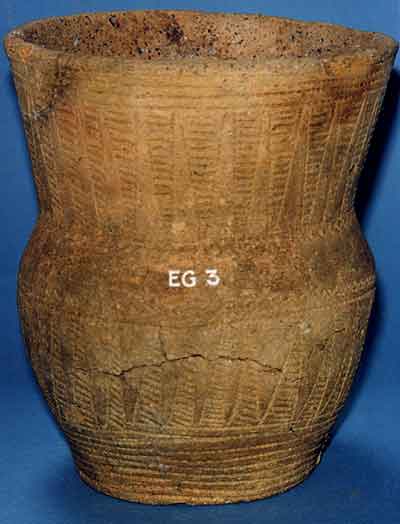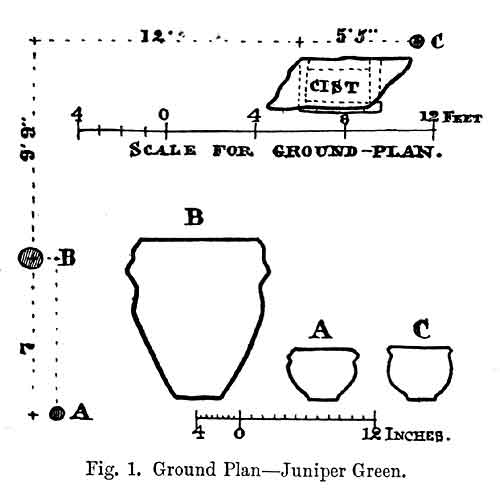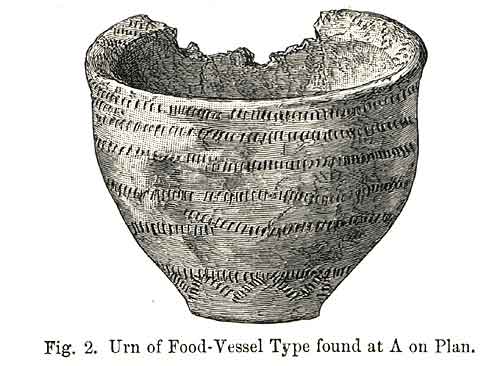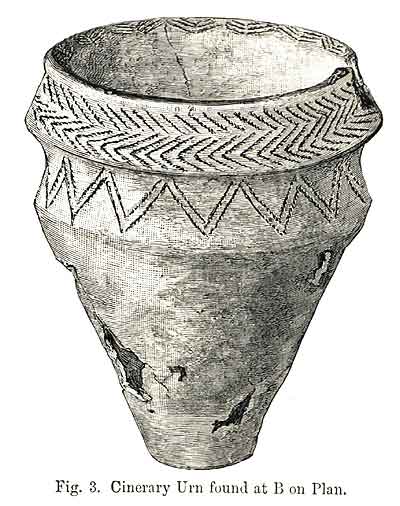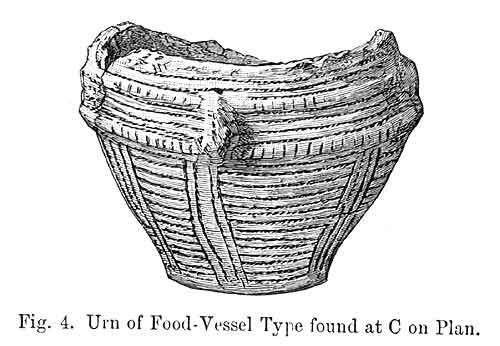Juniper Green in the Bronze Age
Juniper Green can celebrate not just 300 years of its past, but 4300 years or more, back at least into the Early Bronze Age! One skull from this period, which had been dug up (as part of a complete skeleton) in May 1851 in a garden close to the Edinburgh-Lanark road, has recently been the subject of scientific analysis and radiocarbon dating. The results are presented for the first time on this website.
The 1851 find
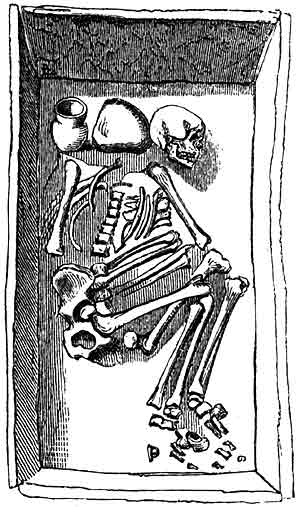
© reproduced from Davis & Thurnam's Crania Britannica
Juniper Green Cist, with Skeleton and Beaker in situ.
The skeleton was found in a carefully-constructed cist - a stone box-like grave, around 120 x 60 x 60 centimetres (nearly 4 feet by 2 feet and probably around 2 feet deep), which had been dug into sandy ground. The cist was discovered when digging revealed its large sandstone capstone, around 30-60 centimetres below the ground surface. When it was realised that this was probably an archaeological site of some importance, various antiquarian 'worthies' were invited to come out from Edinburgh to witness the lifting of the capstone. These people included Professor Daniel Wilson, who was the Secretary of the Society of Antiquaries of Scotland at the time, and Mr Robert Chambers. Wilson described the findspot (in his Prehistoric Annals of Scotland, published 1863) as "..occupying a slightly elevated site, which probably marked the traces of the nearly levelled tumulus.." Wilson therefore believed that the cist had originally been covered by a burial mound, which had been ploughed away over the years; the area had long been under cultivation.
The exact findspot of this cist had been uncertain until recent sleuthing work by Professor Beevers allowed it to be pinpointed. We knew, from ancient accounts, that the cist had been found "not more than ten yards" [around 9 metres] from the Edinburgh-Lanark road. Professor Beevers found notes of a talk given by J J Malloch, the Headmaster of Juniper Green School, to the Colinton Literary Society in 1927. In an aside, reference was made to the Bronze Age bones that had been found in Mr Cattanach's garden. In the 1920s, Mr Cattanach lived in a house called Viewforth; the house is now the butcher's shop, and the garden of the house lies very close to the Lanark Road. The National Grid Reference of this location is NT 196686.
The cist had been made watertight by lining the joints between the sandstone side slabs with stone chips and clay, and covering it with a large flat slab. This had preserved the contents well, even though the flesh of the body had long since rotted away. It was thought that some slight traces of a linen garment or body cover were visible when the cist was opened, especially around the legs; but unfortunately this specimen of possible fabric was not retained.
The skeleton was of a well-built man, who had died between the ages of 40 and 55 - a relatively advanced age, for that period. He had been buried in a carefully-constructed cist (stone box-like grave), which had been made watertight. His body had been laid on its left side, in a crouching position as if asleep. His head may originally have rested on a flat, pillow-like stone slab, but had rolled off it as the body decayed. Behind this slab was an upright, finely-decorated pot - a so-called 'Beaker' - which had probably contained an offering of food or drink for his journey into the afterlife. No traces of its former contents were present, but we know from analysis of other similar pots that a cereal-based substance, possibly ale, was present in some such vessels.
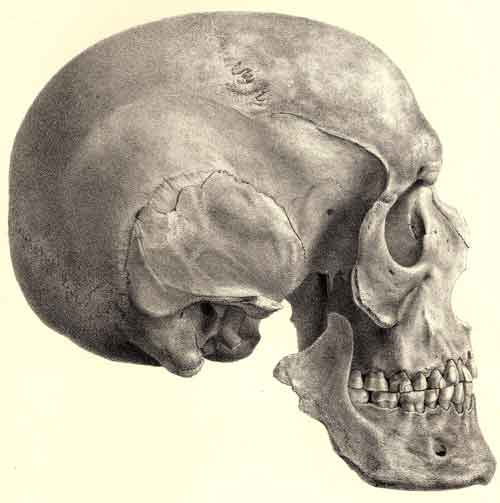
© reproduced from Davis & Thurnam's Crania Britannica
Juniper Green Skull
During the mid-19th century there was much interest in human skulls, as it was thought that they could reveal details about ethnicity and about the personality of the individual. Consequently, the Juniper Green skull was the subject of a study by the eminent craniologists J Barnard Davis and John Thurnam, who published a magnificent (and accurate) engraving in their Crania Britannica (1865). Davis and Thurnam declared it to be of the rounded (brachycephalic) shape that was typical of Early Bronze Age skeletons. Despite having lost part of one side, through contact with the floor of the cist, the skull was heavy (weighing 27 ounces, or 765 grams), and was unusually thick-walled. The teeth had been worn flat through use - a sign of old age, and of a diet that had accidentally included grit from the grinding of grain on stone querns. The teeth, like other prehistoric teeth and unlike modern examples, did not have caries; this means that his diet was not as rich in sweet substances as ours is.
A disadvantage of the interest in human skulls is that, very often, the rest of the skeleton was not collected. This was the case with the Juniper Green specimen: we do not know where the rest of the skeleton is, or whether it was re-buried in the cist. The National Museums Scotland (which was then called the National Museum of Antiquities of Scotland) purchased(!) the skull, and the pot, in 1851; the Registration numbers of these items are NMS X.ET 33 and NMS X.EG 3 respectively.
However, advances in archaeological science have enabled us to obtain fascinating new information from such old finds. As part of a National Museums' Scotland programme to date Scottish Early Bronze Age pottery, a tiny sample of bone from the skull was radiocarbon dated at the University of Oxford in 2003, and found to date to between around 2300 and 2150 BC. This person therefore died around 4,200 years ago! This date is in line with what we know about the use of Beaker pottery in Scotland.
In 2006, the Juniper Green skull also featured in an exciting, Britain-wide project called The Beaker People Project, led by Professor Mike Parker Pearson of Sheffield University and involving an international team of specialists (www.shef.ac.uk/archaeology/research/beaker-isotope). Work is still ongoing, but already we can say - from carbon and nitrogen isotope analysis carried out by Dr Mandy Jay in Leipzig - that this man had a diet that was high in animal protein, and that he did not eat fish - or at least, that marine food did not feature in his diet. Analysis of the strontium and oxygen isotope values of the enamel in one of his back teeth will tell us whether he grew up in the Juniper Green area, since one's tooth enamel contains a record of the geochemical composition of the groundwater in the area where the person's teeth formed. We know that some people around this time DID travel long distances from their childhood home. A man whose grave was found at Amesbury, near Stonehenge in Wiltshire, a few years ago was found to have originated in central Europe! (See http://www.wessexarch.co.uk/projects/amesbury/archer.html for details.)
Other Early Bronze Age graves in Juniper Green
This cist was not the only evidence for prehistoric human activity in Juniper Green. Another Early Bronze Age burial site - this time a cemetery - was found in July 1898, when workmen from Messrs. Cowie & Son, who were preparing to lay foundations, uncovered three pots and a cist. The cist was found to contain bone dust and silt, but no pottery. According to the workmen, all three pots had been found upside down; no mention of any human remains was made. The largest pot is what we now call a Collared Urn. This would originally have contained cremated human remains, and we know from our NMS radiocarbon dating project that it was probably buried around 1900-1600 BC. The other two pots are smaller, and are called Food Vessels. It is unusual to find these upside down, and not associated with human remains; they are normally found inside cists, usually accompanying unburnt human remains (but sometimes accompanying cremated remains). Perhaps the workmen's account was not wholly accurate. These pots are likely to have been buried between 2100 and 1700 BC. Overall, then, this cemetery would have been slightly later than the Beaker cist. The cemetery had almost certainly been bigger: six weeks after these pots had been found, a fourth pot was also discovered, but was stolen overnight. The report of this cemetery can be found in the Proceedings of the Society of Antiquaries of Scotland, volume 33 (1898-9), pages 354-8; you can access PSAS on-line at www.socantscot.org. The urn and two Food Vessels are in the collections of the National Museums Scotland (Reg. Nos. NMS X.EA 153 and NMS X.EE78-9 respectively).
The images shown here have been reproduced by courtesy of the National Museums Scotland (photo of Beaker) and the Society of Antiquaries of Scotland (other pots). The engravings of the skull and the cist have been reproduced from Davis & Thurnam's Crania Britannica.

